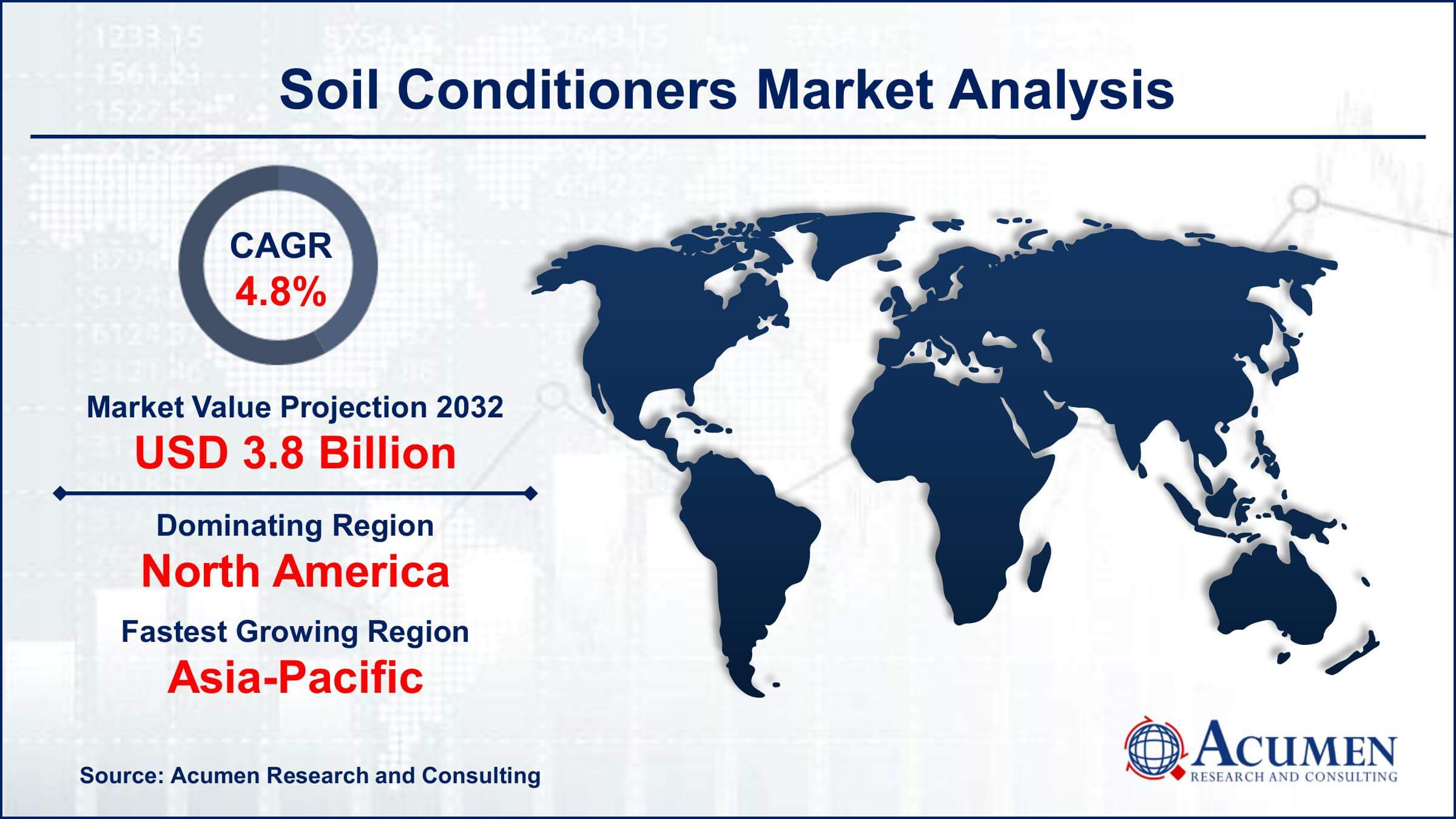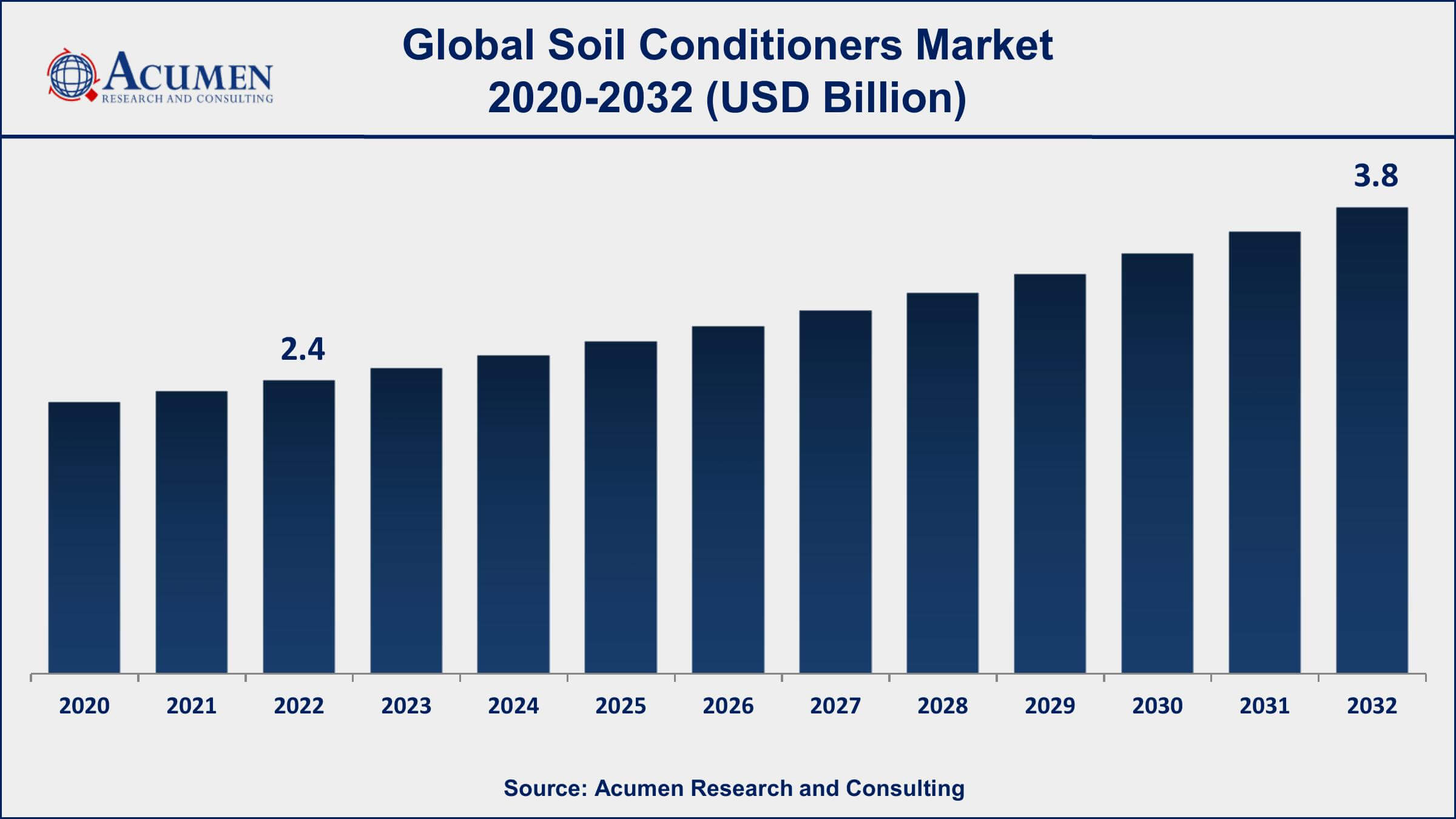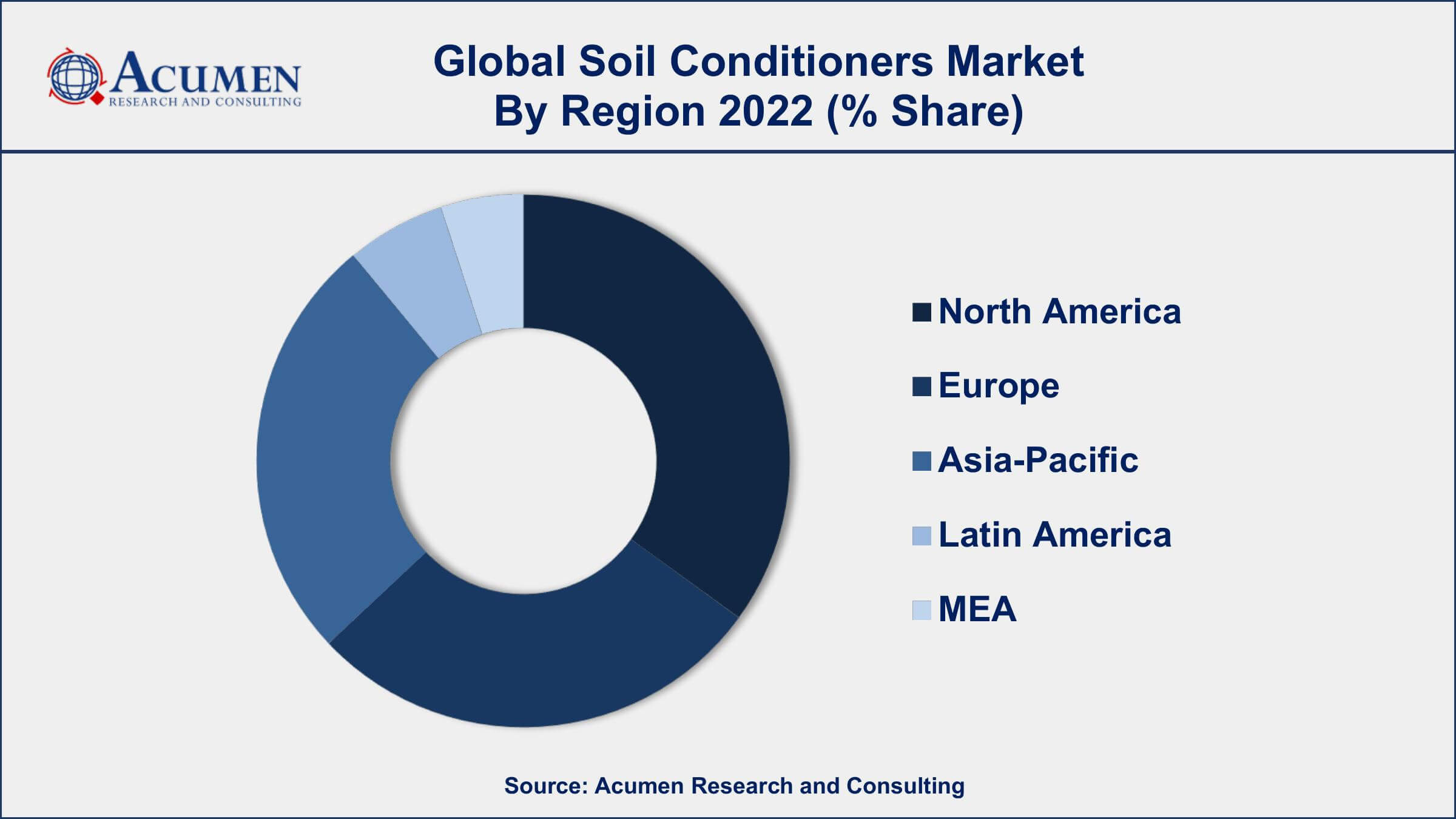February 2023
Soil Conditioners Market Size accounted for USD 2.4 Billion in 2022 and is projected to achieve a market size of USD 3.8 Billion by 2032 growing at a CAGR of 4.8% from 2023 to 2032.
The Global Soil Conditioners Market Size accounted for USD 2.4 Billion in 2022 and is projected to achieve a market size of USD 3.8 Billion by 2032 growing at a CAGR of 4.8% from 2023 to 2032.
Soil Conditioners Market Key Highlights

Soil conditioners are substances that are added to soil to improve its physical, chemical, or biological properties. These conditioners can include organic materials such as compost, manure, and peat moss, as well as inorganic materials such as lime, gypsum, and vermiculite. The main function of soil conditioners is to improve soil structure, increase water retention, and enhance soil fertility, which ultimately leads to healthier plants and higher crop yields. Soil conditioners are commonly used in agriculture, horticulture, landscaping, and gardening.
The global soil conditioners market has been experiencing steady growth over the past few years and is projected to continue growing at a compound annual growth rate (CAGR) of 4.8% from 2023 to 2032. The increasing demand for food due to the growing global population, coupled with the need to improve soil health and productivity, are key factors driving the growth of the soil conditioners market value. In addition, the rising trend towards sustainable agriculture and organic farming practices is also expected to drive market growth, as soil conditioners are a vital component in such practices.

Global Soil Conditioners Market Trends
Market Drivers
Market Restraints
Market Opportunities
Soil Conditioners Market Report Coverage
| Market | Soil Conditioners Market |
| Soil Conditioners Market Size 2022 | USD 2.4 Billion |
| Soil Conditioners Market Forecast 2032 | USD 3.8 Billion |
| Soil Conditioners Market CAGR During 2023 - 2032 | 4.8% |
| Soil Conditioners Market Analysis Period | 2020 - 2032 |
| Soil Conditioners Market Base Year | 2022 |
| Soil Conditioners Market Forecast Data | 2023 - 2032 |
| Segments Covered | By Product Type, By Soil Type, By Solubility, By Application, And By Geography |
| Regional Scope | North America, Europe, Asia Pacific, Latin America, and Middle East & Africa |
| Key Companies Profiled | BASF SE, The Dow Chemical Company, Syngenta AG, Bayer AG, Yara International ASA, Solvay SA, Akzo Nobel N.V., Archer Daniels Midland Company, Novozymes A/S, Evonik Industries AG, The Mosaic Company, and CF Industries Holdings, Inc. |
| Report Coverage |
Market Trends, Drivers, Restraints, Competitive Analysis, Player Profiling, Covid-19 Analysis, Regulation Analysis |
The need for nutrient management in soil for better quality crop yield has enhanced the necessity for soil conditioners. These soil conditioners gained high demand owing to their utilization for various purposes such as improving soil structure, tunneling, and mining and also for improving the damages caused to soil due to improper soil management. Many different materials are considered soil conditioners due to their ability to improve soil quality such as bone meal, coffee grounds, compost, coir, manure, straw, peat, and others. Soil conditioners are now widely used for producing organic products which are in high demand among people.
Natural soil conditioners and synthetic soil conditioners are the two major types of soil conditioners used for soil management. Natural soil conditioners are largely used for soil conditioning for several years owing to their benefits in improving soil structure and low solubility of soil as well as ease of local availability. Soil conditioners play an important role in modern-day agriculture as it has the potential to improve soil fertility, texture, and quality. In addition, soil conditioner is also used for the excavation of soil for tunneling and mining and to stabilize excavated soil. Increasing awareness of soil management leads to the development of the soil conditioner market. However, the adoption rate of soil conditioners is low due to improper awareness about their utilization and acts as a main restraint for the growth of the soil conditioner market.
Soil Conditioners Market Segmentation
The global soil conditioners market segmentation is based on product type, soil type, solubility, application, and geography.
Soil Conditioners Market By Product Type
According to the soil conditioners industry analysis, the inorganic segment accounted for the largest market share in 2022. This growth can be attributed to several factors, including the increasing adoption of modern farming techniques, growing awareness about the benefits of inorganic soil conditioners, and the need to address soil degradation and erosion. In addition, inorganic soil conditioners are less expensive than organic soil conditioners, making them a more cost-effective solution for many farmers. The demand for inorganic soil conditioners is also increasing due to their ability to improve soil drainage and reduce soil compaction, which can lead to higher crop yields. Lime, for example, is commonly used to adjust soil pH levels, which can have a significant impact on crop growth and productivity.
Soil Conditioners Market By Soil Type
In terms of soil types, the sand segment is expected to witness significant growth in the coming years. This growth can be attributed to the increasing demand for sand in agriculture and gardening applications, particularly in regions with heavy soils or poor drainage. Sand is often mixed with other soil conditioners to improve soil structure and prevent soil compaction, which can lead to higher crop yields. One of the key benefits of using sand as a soil conditioner is its ability to increase soil porosity, which allows for better water and air circulation in the soil. This, in turn, can help to prevent waterlogging and soil erosion, and can also promote root growth and nutrient uptake in plants. Sand is also an effective solution for improving the drainage of heavy clay soils, which can be a significant problem in many regions.
Soil Conditioners Market By Solubility
According to the soil conditioners market forecast, the water soluble segment is expected to witness significant growth in the coming years. This growth can be attributed to several factors, including the increasing adoption of modern farming techniques, the rising trend toward sustainable agriculture practices, and the need to address soil degradation and erosion. Water-soluble soil conditioners offer several benefits over other types of soil conditioners. For example, they are easy to apply and can be quickly absorbed by plants, which can lead to faster growth and improved yield. In addition, water-soluble soil conditioners can be customized to meet the specific needs of different crops and soil types, making them a versatile and effective solution for improving soil health and productivity.
Soil Conditioners Market By Application
Based on the application, the agricultural segment is expected to continue its growth trajectory in the coming years. Agricultural soil conditioners are products that are specifically designed to improve soil health and productivity in farming applications. These products are used to address a range of soil-related issues, such as soil erosion, nutrient deficiencies, and soil compaction. The agricultural segment is expected to grow at a significant rate over the forecast period. This growth can be attributed to several factors, including the increasing demand for high-quality crops, the rising trend toward sustainable agriculture practices, and the need to address soil degradation and erosion. Agricultural soil conditioners offer several benefits over traditional farming practices. For example, they can help to improve soil structure and water retention, which can lead to higher crop yields and improved quality.
Soil Conditioners Market Regional Outlook
North America
Europe
Asia-Pacific
Latin America
The Middle East & Africa

Soil Conditioners Market Regional Analysis
North America is currently dominating the global soil conditioners market, with the United States being the largest market in the region. There are several reasons why North America has emerged as a dominant player in this market. One of the key drivers of the soil conditioner market in North America is the increasing demand for sustainable agriculture practices. Farmers in the region are increasingly turning to soil conditioners to improve soil health and productivity while reducing their reliance on synthetic fertilizers and pesticides. This has led to a significant increase in the adoption of soil conditioners in the region, particularly in the United States. Another factor contributing to North America's dominance in the soil conditioners market is the high level of agricultural activity in the region. The United States, for example, is one of the largest agricultural producers in the world, with a vast amount of land dedicated to farming. This has created a significant demand for soil conditioners in the region, as farmers seek to maximize crop yields and maintain the long-term health of their soil.
Soil Conditioners Market Player
Some of the top soil conditioners market companies offered in the professional report include BASF SE, The Dow Chemical Company, Syngenta AG, Bayer AG, Yara International ASA, Solvay SA, Akzo Nobel N.V., Archer Daniels Midland Company, Novozymes A/S, Evonik Industries AG, The Mosaic Company, and CF Industries Holdings, Inc.
Looking for discounts, bulk pricing, or custom solutions? Contact us today at sales@acumenresearchandconsulting.com
February 2023
January 2025
December 2024
May 2024